Home
›
Getting Started
›
Design
Design
Mosaic Designs can be totally abstract or precisely planned but in the beginning simple is best.

It's very easy to find images with minimum detail, which will work best for interpreting into a mosaic.
Children's colouring books can make great patterns for mosaics for the following reasons:
Children's colouring books can make great patterns for mosaics for the following reasons:
- The images have just enough detail but not too much.
- They come in almost every theme imaginable: human figures, animals, vehicles, mythological creatures
- Colouring books are cheap and available almost everywhere.
- You can change the pictures and combine several pictures into one scene.
Since you will probably be converting a simple image with little detail into a more complex work of art, it's necessary to add your own elements of depth, dimension and style as you choose tiles for colour, texture and shading. It's all in the details.
You can draw guidelines directly on the base for reference using a marker pen or you may want to transfer a complex drawing to wood or terracotta bases using carbon paper. Large images can be transferred section by section.
The size of your design will dictate the size of your tesserae.
Small projects call for small pieces with small gaps left in between. On larger projects you can use larger pieces of tesserae with larger gaps. However, it is best to have gaps no wider than 1cm – 3mm is the optimum. The aim will be to have pieces of tesserae approximately all the same size. However, there will be times when you have to nibble a piece to make it fit.
You can draw guidelines directly on the base for reference using a marker pen or you may want to transfer a complex drawing to wood or terracotta bases using carbon paper. Large images can be transferred section by section.
The size of your design will dictate the size of your tesserae.
Small projects call for small pieces with small gaps left in between. On larger projects you can use larger pieces of tesserae with larger gaps. However, it is best to have gaps no wider than 1cm – 3mm is the optimum. The aim will be to have pieces of tesserae approximately all the same size. However, there will be times when you have to nibble a piece to make it fit.
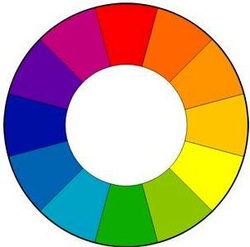
Colour
Lay your tesserae out and play with different colour combinations.
Use the colour wheel to help with colour combinations.
Creating Contrast
Complementary colours are different colours that, when placed next to another colour, increase the total colour contrast of the image. But a complementary colour can’t just be a different shade of one colour, it needs to be a different type of colour altogether.
Maximum contrast can be achieved by using a primary colour and its complementary colour (opposites on the colour wheel). This intensifies and mutually enhances the two colours.
Lay your tesserae out and play with different colour combinations.
Use the colour wheel to help with colour combinations.
Creating Contrast
Complementary colours are different colours that, when placed next to another colour, increase the total colour contrast of the image. But a complementary colour can’t just be a different shade of one colour, it needs to be a different type of colour altogether.
Maximum contrast can be achieved by using a primary colour and its complementary colour (opposites on the colour wheel). This intensifies and mutually enhances the two colours.
Design Styles or "Andamento"
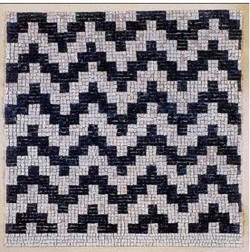
Adamento is the visual flow and direction within a mosaic produced by the placement of rows of tiles (tesserae).
The way tiles are laid can change the design of a mosaic piece. Each Andamento is given a name or Opus, Latin for work. These styles have very different feels and involve differing degrees of skill to execute. Here are the main styles.
Opus Regulatum
Tiles laid in a regular grid pattern are called regulatum, as the name suggests, this is a very regular pattern of tesserae, like bricks in a wall, or squares on a chess board.
The way tiles are laid can change the design of a mosaic piece. Each Andamento is given a name or Opus, Latin for work. These styles have very different feels and involve differing degrees of skill to execute. Here are the main styles.
Opus Regulatum
Tiles laid in a regular grid pattern are called regulatum, as the name suggests, this is a very regular pattern of tesserae, like bricks in a wall, or squares on a chess board.
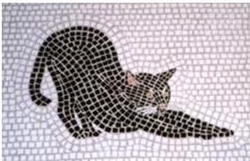
Opus Vermiculatum
Vermiculatum, from the Latin ‘worm-like’ is the most expressive form of mosaic tile laying. The tesserae are laid along the contours of the image, describing its form, you should be able to make a rubbing of the mosaic and see the design. The whole image is given a dynamic power that is unique to mosaics but which is extremely labour intensive and takes a high degree of skill to do well.
The essence is to begin with a tesserae size and complete the mosaic in flowing courses of tesserae of that size.
Vermiculatum, from the Latin ‘worm-like’ is the most expressive form of mosaic tile laying. The tesserae are laid along the contours of the image, describing its form, you should be able to make a rubbing of the mosaic and see the design. The whole image is given a dynamic power that is unique to mosaics but which is extremely labour intensive and takes a high degree of skill to do well.
The essence is to begin with a tesserae size and complete the mosaic in flowing courses of tesserae of that size.
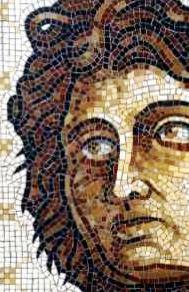
Opus Classicum
As its name suggests this is the traditional style found in many mosaics from the great Roman mosaics of the Levant to the many trade craft Victorian Classical floors that can be found in England. The main objects of a design are created in vermiculatum and these are placed on a more regular, tessellated, background. Where the two meet the background takes the form of the object, so each object has a background halo around it. This technique creates a very strong sharp and clear image.
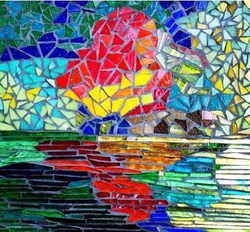
Opus Palladianum
This technique gives a more modern feel. The tesserae are cut into haphazard shapes and laid like crazy paving. This buzzing texture is also used for backgrounds but is labour intensive if done well.
This technique gives a more modern feel. The tesserae are cut into haphazard shapes and laid like crazy paving. This buzzing texture is also used for backgrounds but is labour intensive if done well.
Methods
There are two methods in mosaic work - the direct method and the indirect method.
In the Direct Method the tesserae are glued directly onto the base surface, then grouted.
In the Indirect Method the tesserae are first glued to either mesh or brown craft paper.
If using craft paper then the tesserae are glued up side down and grouted before the piece is attached the the base surface. The advantages of using this method are:
In the Direct Method the tesserae are glued directly onto the base surface, then grouted.
In the Indirect Method the tesserae are first glued to either mesh or brown craft paper.
If using craft paper then the tesserae are glued up side down and grouted before the piece is attached the the base surface. The advantages of using this method are:
- You can work indoors out of the weather if the piece is destined for the outdoors
- If using uneven tesserae the final piece will have a smooth surface
Home
›
Getting Started
›
Design

